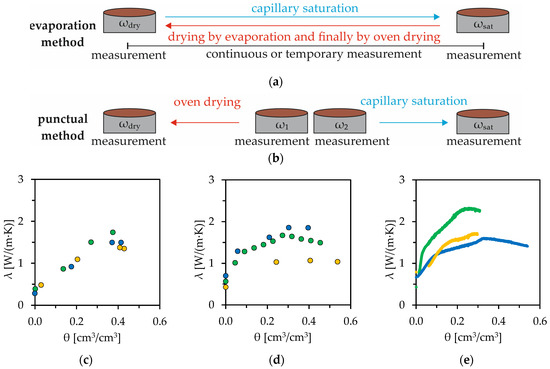Journal Description
Soil Systems
Soil Systems
- formerly Soils - is an international, scientific, peer-reviewed, open access journal on soil science, published quarterly online by MDPI. The Italian Society of Soil Science (SISS) is affiliated with Soil Systems and its members receive discounts on the article processing charges.
- Open Access— free for readers, with article processing charges (APC) paid by authors or their institutions.
- High Visibility: indexed within Scopus, ESCI (Web of Science), AGRIS, PubAg, GeoRef, CAPlus / SciFinder, and other databases.
- Journal Rank: CiteScore - Q1 (Earth-Surface Processes)
- Rapid Publication: manuscripts are peer-reviewed and a first decision is provided to authors approximately 27.7 days after submission; acceptance to publication is undertaken in 3.5 days (median values for papers published in this journal in the second half of 2023).
- Recognition of Reviewers: reviewers who provide timely, thorough peer-review reports receive vouchers entitling them to a discount on the APC of their next publication in any MDPI journal, in appreciation of the work done.
Impact Factor:
3.5 (2022)
Latest Articles
A Practicable Guideline for Predicting the Thermal Conductivity of Unconsolidated Soils
Soil Syst. 2024, 8(2), 47; https://doi.org/10.3390/soilsystems8020047 - 18 Apr 2024
Abstract
►
Show Figures
For large infrastructure projects, such as high-voltage underground cables or for evaluating the very shallow geothermal potential (vSGP) of small-scale horizontal geothermal systems, large-scale geothermal collector systems (LSCs), and fifth generation low temperature district heating and cooling networks (5GDHC), the thermal conductivity (λ)
[...] Read more.
For large infrastructure projects, such as high-voltage underground cables or for evaluating the very shallow geothermal potential (vSGP) of small-scale horizontal geothermal systems, large-scale geothermal collector systems (LSCs), and fifth generation low temperature district heating and cooling networks (5GDHC), the thermal conductivity (λ) of the subsurface is a decisive soil parameter in terms of dimensioning and design. In the planning phase, when direct measurements of the thermal conductivity are not yet available or possible, λ must therefore often be estimated. Various empirical literature models can be used for this purpose, based on the knowledge of bulk density, moisture content, and grain size distribution. In this study, selected models were validated using 59 series of thermal conductivity measurements performed on soil samples taken from different sites in Germany. By considering different soil texture and moisture categories, a practicable guideline in the form of a decision tree, employed by empirical models to calculate the thermal conductivity of unconsolidated soils, was developed. The Hu et al. (2001) model showed the smallest deviations from the measured values for clayey and silty soils, with an RMSE value of 0.20 W/(m∙K). The Markert et al. (2017) model was determined to be the best-fitting model for sandy soils, with an RMSE value of 0.29 W/(m∙K).
Full article
Open AccessArticle
Uncovering Hidden Microbial Diversity in Nitrate/Iodide Deposits (NIDs) in the Domeyko District, Atacama Desert, Chile
by
Mayra Cortés, Priscilla Avendaño, Olga Encalada, Camila Salazar-Ardiles, David C. Andrade, Benito Gómez-Silva, Daniel Contreras, Norman Toro, Dayana Arias and Lorena V. Escudero
Soil Syst. 2024, 8(2), 46; https://doi.org/10.3390/soilsystems8020046 - 16 Apr 2024
Abstract
►▼
Show Figures
Unique worldwide, nitrate/iodine deposits (NIDs) are located along a 700 km geological belt in the Atacama Desert, Chile. They serve as the primary source of mineral ores for the extraction of iodine, sodium, and potassium nitrates. NIDs have been relatively underexplored from a
[...] Read more.
Unique worldwide, nitrate/iodine deposits (NIDs) are located along a 700 km geological belt in the Atacama Desert, Chile. They serve as the primary source of mineral ores for the extraction of iodine, sodium, and potassium nitrates. NIDs have been relatively underexplored from a biological perspective. To address this, we collected sixteen soil samples from abandoned mines in Oficinas Pissis and Savona for chemical, mineralogical, and metagenomic analyses. The soils primarily consisted of halite and darapskite, with only one sample being predominantly composed of thenardite. Deliquescence and water activity measurements yielded values ranging from 0.02% to 0.40% and 0.47 to 0.62, respectively. To investigate the presence, identification, relative abundance, and diversity of microbial life in NID soils, we employed MiSeq high-throughput sequencing and bioinformatic tools. The dominant phyla observed were Firmicutes and Proteobacteria, with Actinobacteria and Cyanobacteria being predominant in two soil samples. Furthermore, we detected nitrate/perchlorate-reducing bacterial activity in enriched cultures from the soil samples. This study sheds light on the resilience of microbial life in the Atacama Desert NIDs, providing compelling evidence for its existence and offering insight into factors that could facilitate it within this unique environment.
Full article
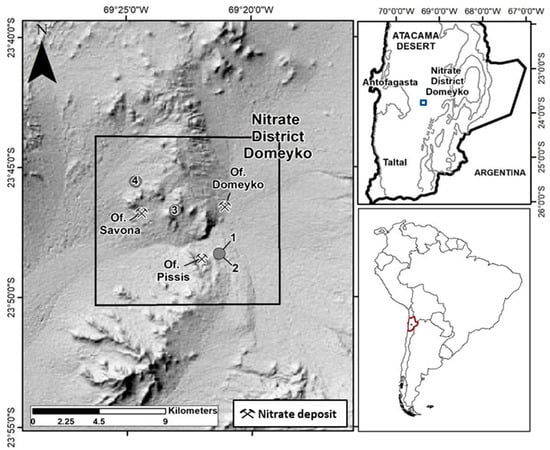
Figure 1
Open AccessReview
Strategies and Public Policies for Soil and Water Conservation and Food Production in Brazil
by
Luis Eduardo Akiyoshi Sanches Suzuki, Helvio Debli Casalinho and Idel Cristiana Bigliardi Milani
Soil Syst. 2024, 8(2), 45; https://doi.org/10.3390/soilsystems8020045 - 15 Apr 2024
Abstract
There is an urgent demand to change our intensive crop production systems, replacing them with soil use and management systems that recover, preserve, or improve soil health and are environmentally sustainable, producing healthy and good-quality food. In this work, we compile and present
[...] Read more.
There is an urgent demand to change our intensive crop production systems, replacing them with soil use and management systems that recover, preserve, or improve soil health and are environmentally sustainable, producing healthy and good-quality food. In this work, we compile and present strategies and public policies aimed toward soil and water conservation and food production in Brazil. The results presented may help Brazilian farmers adopt practices to recover, maintain, or improve soil health and politicians to create or modify public policies for healthy soil and food, without the necessity of increasing agricultural areas. Food insecurity was also addressed, with family farming playing an important role in food production and decreasing food insecurity. But these challenges need the combined efforts and engagement of the whole society.
Full article
(This article belongs to the Special Issue Research on Soil Management and Conservation: 2nd Edition)
►▼
Show Figures
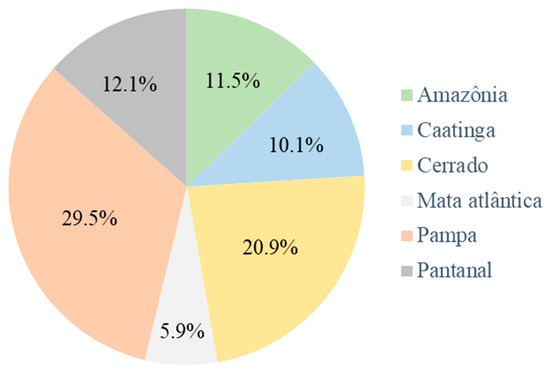
Figure 1
Open AccessArticle
Fractions of Organic Matter and Soil Carbon Balance in Different Phases of an Agroforestry System in the Cerrado: A Ten-Year Field Assessment
by
Juscelina Arcanjo dos Santos, Anselmo de Deus dos Santos, Camila Rodrigues Costa, Alyson Silva de Araujo, Gilberto Gonçalves Leite, Thais Rodrigues Coser and Cícero Célio de Figueiredo
Soil Syst. 2024, 8(2), 44; https://doi.org/10.3390/soilsystems8020044 - 10 Apr 2024
Abstract
►▼
Show Figures
Integrated production systems composed of trees, crops and pastures have shown good results in improving soil quality and the capacity to store carbon in the soil, being efficient in mitigating greenhouse gas emissions. Despite this, changes in carbon stocks and soil organic matter
[...] Read more.
Integrated production systems composed of trees, crops and pastures have shown good results in improving soil quality and the capacity to store carbon in the soil, being efficient in mitigating greenhouse gas emissions. Despite this, changes in carbon stocks and soil organic matter fractions in the initial stages of implementing an agroforestry system remain unclear. This study evaluated the carbon balance and the dynamics of soil organic matter fractions in an agroforestry system conducted over a decade. Total carbon, labile carbon, carbon from particulate organic matter, organic carbon associated with minerals and inert carbon were determined at depths 0–10 cm, 10–20 cm and 20–40 cm. Soil carbon stocks were also estimated for the 0–40 cm depth. Total carbon increased in the agroforestry system compared with a low-productivity pasture. The total carbon stock in the last growing season (68.57 Mg ha−1) was close to the original soil stocks under native Cerrado vegetation (76.5 Mg ha−1). After 10 years, there was a positive balance in the soil carbon stock of both the total carbon and the soil organic matter fractions. The successional agroforestry system is a good alternative to increasing soil total carbon stocks and labile and non-labile fractions of soil organic matter.
Full article
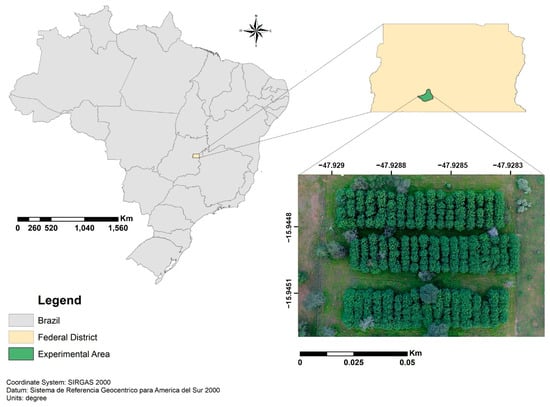
Figure 1
Open AccessArticle
The Loss of Soil Parent Material: Detecting and Measuring the Erosion of Saprolite
by
Daniel L. Evans, Bernardo Cândido, Ricardo M. Coelho, Isabella C. De Maria, Jener F. L. de Moraes, Anette Eltner, Letícia L. Martins and Heitor Cantarella
Soil Syst. 2024, 8(2), 43; https://doi.org/10.3390/soilsystems8020043 - 09 Apr 2024
Abstract
►▼
Show Figures
Soil parent material is a fundamental natural resource for the generation of new soils. Through weathering processes, soil parent materials provide many of the basic building blocks for soils and have a significant bearing on the physico-chemical makeup of the soil profile. Parent
[...] Read more.
Soil parent material is a fundamental natural resource for the generation of new soils. Through weathering processes, soil parent materials provide many of the basic building blocks for soils and have a significant bearing on the physico-chemical makeup of the soil profile. Parent materials are critical for governing the stock, quality, and functionality of the soil they form. Most research on soil parent materials to date has aimed to establish and measure the processes by which soil is generated from them. Comparatively little work has been performed to assess the rates at which soil parent materials erode if they are exposed at the land surface. This is despite the threat that the erosion of soil parent materials poses to the process of soil formation and the loss of the essential ecosystem services those soils would have provided. A salient but unanswered question is whether the erosion of soil parent materials, when exposed at the land surface, outpaces the rates at which soils form from them. This study represents one of the first to detect and measure the loss of soil parent material. We applied Uncrewed Aerial Vehicle Structure-From-Motion (UAV-SfM) photogrammetry to detect, map, and quantify the erosion rates of an exposed saprolitic (i.e., weathered bedrock) surface on an agricultural hillslope in Brazil. We then utilized a global inventory of soil formation to compare these erosion rates with the rates at which soils form in equivalent lithologies and climatic contexts. We found that the measured saprolite erosion rates were between 14 and 3766 times faster than those of soil formation in similar climatic and lithological conditions. While these findings demonstrate that saprolite erosion can inhibit soil formation, our observations of above-ground vegetation on the exposed saprolitic surface suggests that weathered bedrock has the potential to sustain some biomass production even in the absence of traditional soils. This opens up a new avenue of enquiry within soil science: to what extent can saprolite and, by extension, soil parent materials deliver soil ecosystem services?
Full article
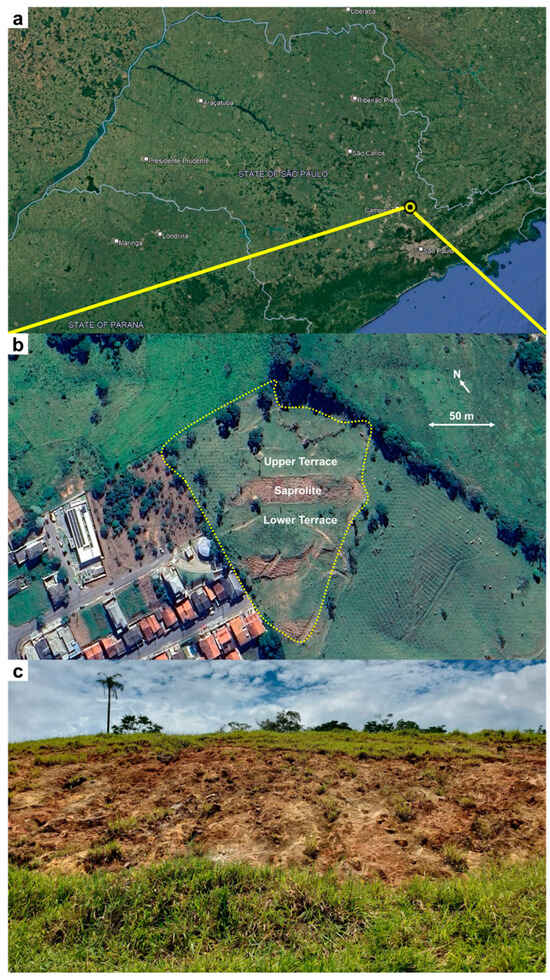
Figure 1
Open AccessEditorial
Research on Soil Management and Conservation
by
Luis Eduardo Akiyoshi Sanches Suzuki
Soil Syst. 2024, 8(2), 42; https://doi.org/10.3390/soilsystems8020042 - 05 Apr 2024
Abstract
The soil is the base of a sustainable agricultural system; it is the key for food and energy production, a reservoir of water and nutrients [...]
Full article
(This article belongs to the Special Issue Research on Soil Management and Conservation)
Open AccessArticle
Long-Term Cropping Management Practices Affect the Biochemical Properties of an Alabama Ultisol
by
Dexter B. Watts, Zhongqi He, Xinhua Yin, H. Allen Torbert, Zachary N. Senwo and Haile Tewolde
Soil Syst. 2024, 8(2), 41; https://doi.org/10.3390/soilsystems8020041 - 05 Apr 2024
Abstract
Interest in improving the long-term sustainability of agricultural production systems has focused on identifying management practices that promote soil health. No tillage, cover cropping, and amending soils with broiler (Gallus gallus domesticus L.) litter are commonly adopted conservation practices that have been
[...] Read more.
Interest in improving the long-term sustainability of agricultural production systems has focused on identifying management practices that promote soil health. No tillage, cover cropping, and amending soils with broiler (Gallus gallus domesticus L.) litter are commonly adopted conservation practices that have been shown to improve soil fertility and crop yield. However, the overall influence of these conservation practices on soil health in the southeastern US are not well understood. Thus, a study was conducted to evaluate the influence of tillage, broiler litter (BL) applications, and cropping systems on soil biochemical properties. Soils were collected from field research plots under long-term management (>than 25 years of tillage, 15 years of broiler litter application, and 15 years of cropping system). Soil microbial biomass, C, N, and P, amidohydrolases, and dissolved organic matter (DOM) were evaluated as indicators of soil health. Adopting tillage and BL into the agricultural management system modified the biochemical parameters of the soils evaluated. Most of these modifications occurred in the 0–5 cm depth. Higher microbial biomass carbon (MBC; 85%) and nitrogen (MBN; 10%) and enzyme activities of asparaginase (65%) and glutaminase (70%) were observed in the 0–5 cm depth under no tillage (NT) compared to conventional tillage (CT), indicating greater biological activities were established in these soil ecosystems. Broiler litter applications increased microbial biomass N and activities of asparaginase and glutaminase in both soil depths. In addition, microbial biomass phosphorus (MBP) was increased following BL application in the 0–5 cm depth. The results suggest that long-term management of NT and BL additions can improve the health of eroded southeastern US soils by altering the soil biochemical parameters.
Full article
(This article belongs to the Topic Carbon and Nitrogen Cycling in Agro-Ecosystems and Other Anthropogenically Maintained Ecosystems)
►▼
Show Figures
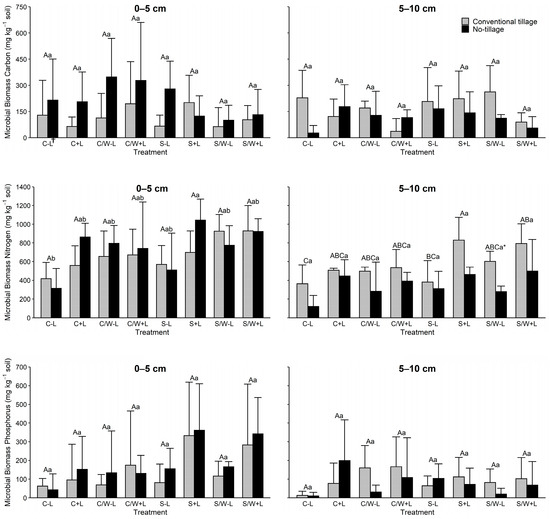
Figure 1
Open AccessArticle
Impact of Biosolids-Derived Biochar on the Remediation and Ecotoxicity of Diesel-Impacted Soil
by
Charles Chinyere Dike, Christian Krohn, Leadin S. Khudur, Alka Rani Batra, Mac-Anthony Nnorom, Aravind Surapaneni, Kalpit Shah and Andrew S. Ball
Soil Syst. 2024, 8(2), 40; https://doi.org/10.3390/soilsystems8020040 - 03 Apr 2024
Abstract
This study aimed to investigate the impact of biosolids-derived biochar on the remediation of Australian soil contaminated with diesel while investigating the role of biochar in the remediation. To achieve the latter aim, sodium azide (NaN3) was added to a separate
[...] Read more.
This study aimed to investigate the impact of biosolids-derived biochar on the remediation of Australian soil contaminated with diesel while investigating the role of biochar in the remediation. To achieve the latter aim, sodium azide (NaN3) was added to a separate biochar treatment (BN) to alter the bacterial community structure. Biochar (B) reduced detectable hydrocarbons by 2353 mg/kg compared to the control (C) treatment at week 24. However, the BN treatment reduced the hydrocarbon concentration by 3827 and 6180 mg/kg, relative to B and C, respectively. Soil toxicity significantly decreased at week 24 compared to the start of the remediation in B, but not in the control. Biochar and control treatments generally showed a similar bacterial community structure throughout the incubation, while the bacterial community structure in BN differed significantly. Biodegradation was found to play a significant role in hydrocarbon removal, as the variation in the bacteria community coincided with differences in hydrocarbon removal between B and BN. The increased removal of hydrocarbons in the BN treatment relative to B coincided with increased and reduced relative abundances of Gordonia and JG30-KF-CM45 genera, respectively. This study showed that NaN3 led to a transient and selective inhibition of bacteria. This study makes an important contribution towards understanding the use of NaN3 in examining the role of biochar in the remediation of diesel-contaminated soil. Overall, we conclude that biochar has the potential to enhance the remediation of diesel-contaminated soil and that biodegradation is the dominant mechanism.
Full article
(This article belongs to the Special Issue Soil Bioremediation)
►▼
Show Figures
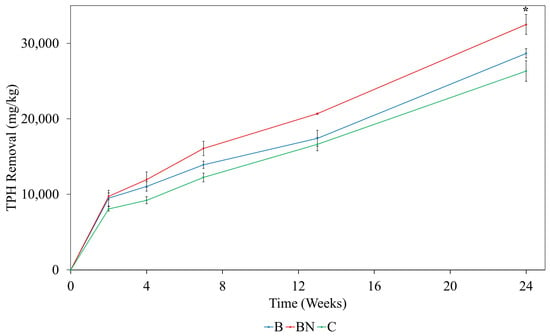
Figure 1
Open AccessArticle
Deciphering the Structural and Functional Diversity of Rhizobacteria from Stone Pine Inoculated with Plant Growth Promoting Rhizobacteria (PGPR) before and after Transplanted into Degraded Agricultural Soil
by
Ana Garcia-Villaraco, Beatriz Ramos Solano, Francisco Javier Gutierrez-Mañero and José Antonio Lucas
Soil Syst. 2024, 8(2), 39; https://doi.org/10.3390/soilsystems8020039 - 26 Mar 2024
Abstract
►▼
Show Figures
The use of plant growth-promoting rhizobacteria (PGPR) inoculated on plants has shown that it can increase the success of reforestation and accelerate soil recovery by improving soil microbial diversity. Three PGPR isolated from natural pine populations were selected for their metabolic capabilities and
[...] Read more.
The use of plant growth-promoting rhizobacteria (PGPR) inoculated on plants has shown that it can increase the success of reforestation and accelerate soil recovery by improving soil microbial diversity. Three PGPR isolated from natural pine populations were selected for their metabolic capabilities and taxonomic affiliation (Z4.3; Bacillus sp., Z5.4; Arthobacter sp., and Z7.15; and Pseudomonas sp.) when inoculated alone or in combination (consortium) on stone pine seedlings before transplanting to the field. Before transplanting and after nine months, rhizospheric soil samples were collected for structural and functional metagenomic studies. First, the data were analyzed using EasyMAP. Neither alpha nor beta diversity showed significant differences between the samples, although unique taxa representative of each sample were detected. The predominant phylum in all cases was Proteobacteria, followed by Bacteroidetes and Acidobacteria. The linear discriminant analysis (LDA) effect size (LEfSe) found significantly over-represented taxa in some samples, highlighting different representatives of the order Sphingomonadales in several of them. Functional inference performed with PICRUSt also showed significantly over-represented functions in some samples. The study demonstrates that PGPR have a positive effect on plants and cause detectable changes in microbial communities in terms of both structure and function.
Full article
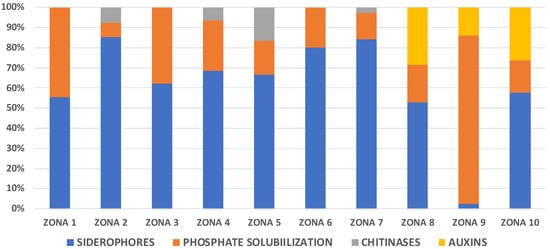
Figure 1
Open AccessArticle
Soil-Forming Factors of High-Elevation Mountains along the East African Rift Valley: The Case of the Mount Guna Volcano, Ethiopia
by
Mekonnen Getahun Sisay, Enyew Adgo Tsegaye, Alemayehu Regassa Tolossa, Jan Nyssen, Amaury Frankl, Eric Van Ranst and Stefaan Dondeyne
Soil Syst. 2024, 8(2), 38; https://doi.org/10.3390/soilsystems8020038 - 24 Mar 2024
Abstract
►▼
Show Figures
The soils of the high-elevation mountains along the East African Rift Valley are poorly understood. Assessing the potential of soils for agriculture, climate change mitigation, and environmental functioning requires insight into how they relate to the factors influencing soil formation. Between 3000 and
[...] Read more.
The soils of the high-elevation mountains along the East African Rift Valley are poorly understood. Assessing the potential of soils for agriculture, climate change mitigation, and environmental functioning requires insight into how they relate to the factors influencing soil formation. Between 3000 and 4120 m a.s.l., 85 soil profiles of Mount Guna were described and sampled. Standard physicochemical analyses were done on all pedons. Additionally, X-ray diffraction, Alox and Feox content, and P fixation were performed on six selected profiles. Soils on Mount Guna included Andosols, Phaeozems, Leptosols, Regosols, Cambisols, Luvisols, and Vertisols. With increasing elevation, clay content, bulk density, and pH decreased while the C:N ratio remained constant. In contrast, sand, silt, silt-to-clay ratio, SOC, Ntotal, and SOCS increased. With a factor analysis, the soil-forming factors’ elevation/climate could be disentangled from the factor’s parent material as these affect topsoil and subsoil differently. In the ordination based on climate/elevation and parent material, Andosols and Vertisols stood out while other Reference Soil Groups (RSG) showed indistinct patterns. Soil erosion appeared as an additional soil-forming factor not accounted for by the factor analysis. The distribution of the RSG was significantly associated with elevation belts (p < 0.001), lithology (p < 0.001), and landcover (p < 0.003). On the summital ridge, the Andosols were crucial for groundwater storage due to high precipitation. Shallow and stony soils in the mid-elevation belt contributed to runoff generation. Average soil carbon stock ranged from 8.1 to 11 kg C m−2 in the topsoil and from 29.2 to 31.9 kg C m−2 in the upper meter, emphasizing the global importance of high-elevation areas for carbon sequestration.
Full article
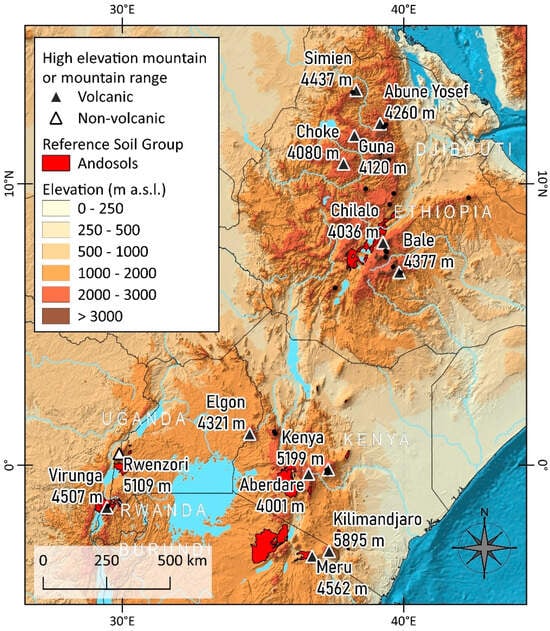
Figure 1
Open AccessArticle
Effects of Past Sulfur Deposition on the Soil Microbial Biomass at Spruce Forest Sites
by
Dorit Julich, Stefan Julich, Karl-Heinz Feger, Tobias Klauder and Jeroen H. T. Zethof
Soil Syst. 2024, 8(2), 37; https://doi.org/10.3390/soilsystems8020037 - 23 Mar 2024
Abstract
►▼
Show Figures
During the last decades, forest soils in Central Europe recovered from former sulfur and acid deposition. As external S input into forests has strongly decreased and legacy S pools in the soils are diminishing, internal S cycling through mineralization will increasingly become important
[...] Read more.
During the last decades, forest soils in Central Europe recovered from former sulfur and acid deposition. As external S input into forests has strongly decreased and legacy S pools in the soils are diminishing, internal S cycling through mineralization will increasingly become important for ecosystem nutrition. However, it is not known how microbial biomass is affected by the S pool change in the formerly S surplus soils. Here, we present data on the status quo of C, N, and S in microbial biomass in relation to contents in mineral soil and organic layer. The results of forest soil in Eastern Germany (low and high liming), which is slowly recovering from former pollution, are compared to those of a site remote from air pollution in the Swiss Alps. The contents of C, N, and S in soil as well as in microbial biomass were clearly higher in the organic layer than in mineral topsoil at all sites. Despite the generally low content in the mineral A-horizon, the clean-air site showed indications of a more active S-turnover as compared to the high-pollution site. Liming at the high-pollution site improved the conditions for microbial growth (pH increase) in the organic layer resulting in more mobile S.
Full article
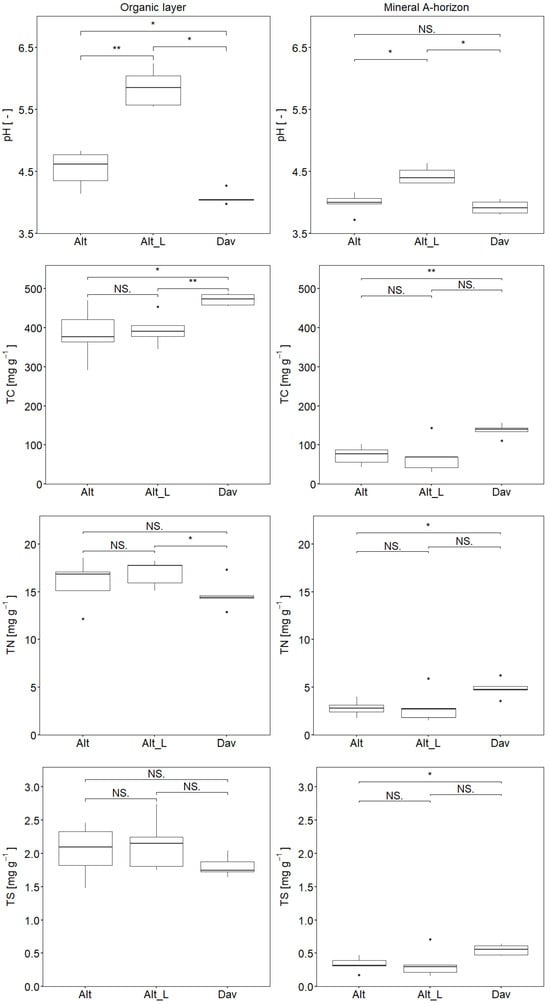
Figure 1
Open AccessReview
Soil Contamination by Heavy Metals and Radionuclides and Related Bioremediation Techniques: A Review
by
Yelizaveta Chernysh, Viktoriia Chubur, Iryna Ablieieva, Polina Skvortsova, Olena Yakhnenko, Maksym Skydanenko, Leonid Plyatsuk and Hynek Roubík
Soil Syst. 2024, 8(2), 36; https://doi.org/10.3390/soilsystems8020036 - 22 Mar 2024
Abstract
The migration of heavy metals and radionuclides is interrelated, and this study focusses on the interaction and complex influence of various toxicants. The rehabilitation of radioactively contaminated territories has a complex character and is based on scientifically supported measures to restore industrial, economic,
[...] Read more.
The migration of heavy metals and radionuclides is interrelated, and this study focusses on the interaction and complex influence of various toxicants. The rehabilitation of radioactively contaminated territories has a complex character and is based on scientifically supported measures to restore industrial, economic, and sociopsychological relations. We aim for the achievement of pre-emergency levels of hygienic norms of radioactive contamination of output products. This, in its sum, allows for further economic activity in these territories without restrictions on the basis of natural actions of autoremediation. Biosorption technologies based on bacterial biomass remain a promising direction for the remediation of soils contaminated with radionuclides and heavy metals that help immobilise and consolidate contaminants. A comprehensive understanding of the biosorption capacity of various preparations allows for the selection of more effective techniques for the elimination of contaminants, as well as the overcoming of differences between laboratory results and industrial use. Observation and monitoring make it possible to evaluate the migration process of heavy metals and radionuclides and identify regions with a disturbed balance of harmful substances. The promising direction of the soil application of phosphogypsum, a by-product of the chemical industry, in bioremediation processes is considered.
Full article
(This article belongs to the Special Issue Research on Heavy Metals in Soils and Sediments)
►▼
Show Figures
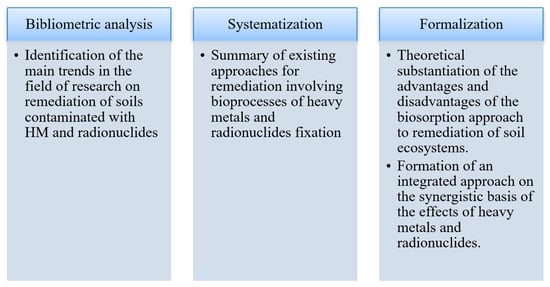
Figure 1
Open AccessArticle
Effects of Seed Priming on Mitigating the Negative Effects of Increased Salinity in Two Varieties of Sweet Pepper (Capsicum annuum L.)
by
Erna Karalija, Ajna Lošić, Arnela Demir and Dunja Šamec
Soil Syst. 2024, 8(1), 35; https://doi.org/10.3390/soilsystems8010035 - 17 Mar 2024
Abstract
The increase in soil salinity has a negative effect on the growth and yield of plants. Mitigating the negative effects of soil salinity is therefore a difficult task and different methods are being used to overcome the negative effects of salt stress on
[...] Read more.
The increase in soil salinity has a negative effect on the growth and yield of plants. Mitigating the negative effects of soil salinity is therefore a difficult task and different methods are being used to overcome the negative effects of salt stress on crop plants. One of the often-used approaches is seed priming that can increase plants’ vigor and resilience. In this paper, we tested the effects of hydropriming, proline priming, and salicylic acid priming on the mitigation of the negative effects of salt stress on two bell pepper varieties (Capsicum annuum L.): Herkules and Kurtovska kapija. Sweet bell pepper seeds were primed following desiccation to achieve the original water content, and subsequently cultivated in salt-supplemented medium. The positive effects on vigor (in the form of increased germination and seedling establishment) as well as on level of tolerance for salt stress were recorded for both cultivars. The positive effects varied between the priming treatments and pepper cultivar used. The results of germination, seedling performance, photosynthetic pigments, and osmolytes were measured for seedlings grown from unprimed and primed seeds with under 0, 25, and 50 mM of NaCl. Both cultivars demonstrated greater germination when primed with proline and salicylic acid, while the Herkules cultivar demonstrated a higher tolerance to salt when proline was used as the priming agent. Priming with salicylic acid and proline in the seed improved germination and seedling performance, which could be related to the increase in proline content in the seedlings.
Full article
(This article belongs to the Special Issue Crop Response to Soil and Water Salinity)
►▼
Show Figures
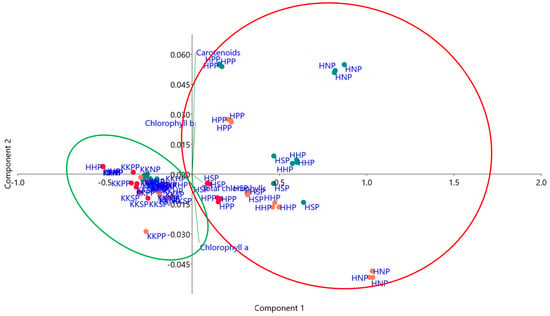
Figure 1
Open AccessArticle
Priming of Soil Organic Carbon Decomposition Induced by Exogenous Organic Carbon Input Depends on Vegetation and Soil Depth in Coastal Salt Marshes
by
Yaru Zhang, Xue Li, Baohua Xie, Xiaojie Wang, Mingliang Zhao, Guangxuan Han, Yongjin Chen and Weimin Song
Soil Syst. 2024, 8(1), 34; https://doi.org/10.3390/soilsystems8010034 - 14 Mar 2024
Abstract
►▼
Show Figures
The input of fresh organic carbon into soils can stimulate organic carbon mineralization via priming effects (PEs). However, little is known about the characterization of PEs in coastal wetlands. We investigated the PEs of two salt marshes (Suaeda salsa and Phragmites australis
[...] Read more.
The input of fresh organic carbon into soils can stimulate organic carbon mineralization via priming effects (PEs). However, little is known about the characterization of PEs in coastal wetlands. We investigated the PEs of two salt marshes (Suaeda salsa and Phragmites australis) in the Yellow River Delta by adding 13C-labeled glucose to soils collected from the 0–10 cm and 20–30 cm layers of both salt marshes. The addition of glucose produced a significant positive PE in both soil layers for both vegetation types. There were no differences in the PE of the topsoil layer between the two vegetation types (p > 0.05), whereas the PE of S. salsa was 19.5% higher than that of P. australis in the subsoil layer (p < 0.05). In addition, the topsoil layer showed a higher average PE of 29.1% compared to that of the subsoil layer for both vegetation types (p < 0.05). The differences in the PEs between the two vegetation types and the two layers could be associated with a differential soil salinity, substrate availability, and microbial community structure. Our findings highlight the important role of PEs in regulating the soil carbon storage of coastal salt marshes, which should be considered when assessing and modeling the soil carbon cycling of coastal wetlands.
Full article
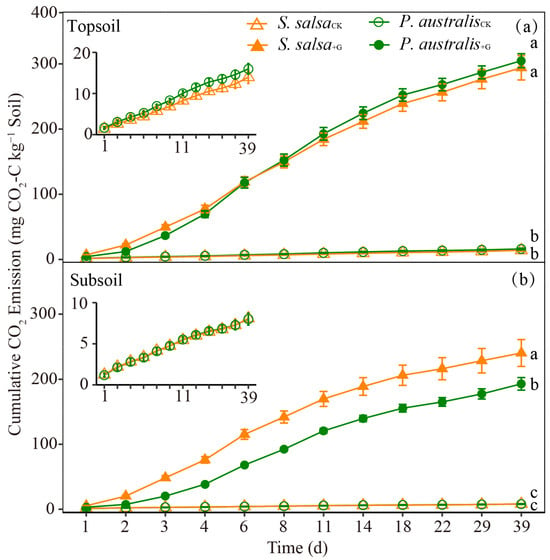
Figure 1
Open AccessArticle
Remediation of Leachate-Metal-Contaminated Soil Using Selected Bacterial Consortia
by
Chijioke Emenike, Patricia Omo-Okoro, Agamuthu Pariatamby, Jayanthi Barasarathi and Fauziah Shahul Hamid
Soil Syst. 2024, 8(1), 33; https://doi.org/10.3390/soilsystems8010033 - 13 Mar 2024
Abstract
Approximately 95% of urban solid waste worldwide is disposed of in landfills. About 14 million metric tonnes of this municipal solid waste are disposed of in landfills every year in Malaysia, illustrating the importance of landfills. Landfill leachate is a liquid that is
[...] Read more.
Approximately 95% of urban solid waste worldwide is disposed of in landfills. About 14 million metric tonnes of this municipal solid waste are disposed of in landfills every year in Malaysia, illustrating the importance of landfills. Landfill leachate is a liquid that is generated when precipitation percolates through waste disposed of in a landfill. High concentrations of heavy metal(loid)s, organic matter that has been dissolved and/or suspended, and inorganic substances, including phosphorus, ammonium, and sulphate, are present in landfill leachate. Globally, there is an urgent need for efficient remediation strategies for leachate-metal-contaminated soils. The present study expatiates on the physicochemical conditions and heavy metal(loid)s’ concentrations present in leachate samples obtained from four landfills in Malaysia, namely, Air Hitam Sanitary Landfill, Jeram Sanitary landfill, Bukit Beruntung landfill, and Taman Beringin Landfill, and explores bioaugmentation for the remediation of leachate-metal-contaminated soil. Leachate samples (replicates) were taken from all four landfills. Heavy metal(loids) in the collected leachate samples were quantified using inductively coupled plasma mass spectrometry. The microbial strains used for bioaugmentation were isolated from the soil sample collected from Taman Beringin Landfill. X-ray fluorescence spectrometry was used to analyze heavy metal(loid)s in the soil, prior to the isolation of microbes. The results of the present study show that the treatments inoculated with the isolated bacteria had greater potential for bioremediation than the control experiment. Of the nine isolated microbial strains, the treatment regimen involving only three strains (all Gram-positive bacteria) exhibited the highest removal efficiency for heavy metal(loid)s, as observed from most of the results. With regard to new findings, a significant outcome from the present study is that selectively blended microbial species are more effective in the remediation of leachate-metal-contaminated soil, in comparison to a treatment containing a higher number of microbial species and therefore increased diversity. Although the leachate and soil samples were collected from Malaysia, there is a global appeal for the bioremediation strategy applied in this study.
Full article
(This article belongs to the Special Issue Soil Bioremediation)
►▼
Show Figures
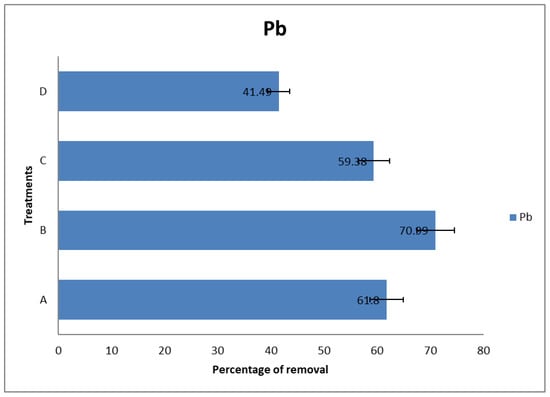
Figure 1
Open AccessArticle
Combined Effects of Rice Husk Biochar and Organic Manures on Soil Chemical Properties and Greenhouse Gas Emissions from Two Different Paddy Soils
by
War War Mon, Yo Toma and Hideto Ueno
Soil Syst. 2024, 8(1), 32; https://doi.org/10.3390/soilsystems8010032 - 10 Mar 2024
Abstract
The application of biochar is considered an alternative amendment strategy for improving soil fertility. In this study, we performed pot experiments using soils of low and medium fertility to assess the effects of different combinations of biochar and organic manure on the chemical
[...] Read more.
The application of biochar is considered an alternative amendment strategy for improving soil fertility. In this study, we performed pot experiments using soils of low and medium fertility to assess the effects of different combinations of biochar and organic manure on the chemical properties of paddy rice soils and determined the best combination to improve the grain yield without increasing N2O and CH4 emissions. The applied treatments were without biochar (control), the application of rice husk biochar alone (5 and 10 t ha−1), and biochar combined with chicken or cow manure. The results indicated that for both soils, the application of 5 t ha−1 biochar combined with 5 t ha−1 chicken manure increased grain yield by improving soil total nitrogen and soil NH4+-N without increasing cumulative N2O and CH4 emissions. Multiple regression analysis showed that when combined with biochar, chicken manure significantly contributed to a higher grain yield and was negatively associated with cumulative CH4, N2O emissions, and total GWP. Furthermore, regardless of soil type, combined applications of biochar and cow manure promoted significant increases in soil available P. Our findings indicate that the C/N ratio of organic manure influences CH4 fluxes, and soil type was identified as a factor driving greenhouse gas emissions.
Full article
(This article belongs to the Special Issue Advances in Fertilizer Technologies and Use to Improve Nutrient Efficiency and Minimize Environmental Impacts)
►▼
Show Figures
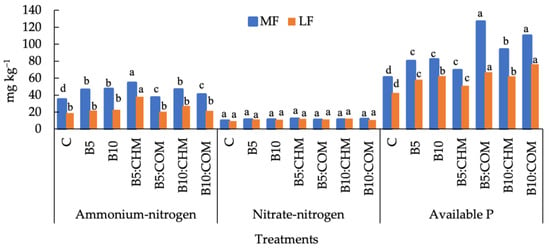
Figure 1
Open AccessArticle
Water Infiltration in Different Soil Covers and Management in the Cerrado–Amazon Ecotone, Brazil
by
Marco Aurélio Barbosa Alves, Daniela Roberta Borella, Rhavel Salviano Dias Paulista, Frederico Terra de Almeida, Adilson Pacheco de Souza and Daniel Fonseca de Carvalho
Soil Syst. 2024, 8(1), 31; https://doi.org/10.3390/soilsystems8010031 - 08 Mar 2024
Abstract
Soil water infiltration is an important component of the hydrological cycle, and it is best evaluated when the raindrop impacts the ground surface. For this reason, it is affected by changes in land use and land cover and by the characteristics and physical–hydric
[...] Read more.
Soil water infiltration is an important component of the hydrological cycle, and it is best evaluated when the raindrop impacts the ground surface. For this reason, it is affected by changes in land use and land cover and by the characteristics and physical–hydric properties of the soil. This study aimed to evaluate soil water infiltration in areas occupied by annual crops (soybean and corn) and pastures in two watersheds of the Teles Pires River-MT, using simulated rainfall, physical models, and principal component analysis. Infiltration rates were evaluated based on simulated rainfall with an average intensity of 75 mm h−1, with four repetitions per region (upper, middle, and lower) of the hydrographic sub-basins of the Caiabi and Renato rivers, and soil use with cover, without cover, and disturbed. Soil tillage provided higher water infiltration rates into the soil, especially in pasture areas in the two hydrographic sub-basins. There were significant adjustments to the mathematical models based on the infiltration rate data for all land use and land cover conditions. The soil attributes that most interfered with the infiltration rate were microporosity, bulk density, and total porosity in the crop areas of the middle Caiabi and microporosity, clay content, total porosity, and silt content in the areas farming at the source of the Renato River. The Horton and Philip models presented the best adjustments in the hydrographic sub-basins of the Caiabi and Renato Rivers, which are recommended for estimating the water infiltration rate into the soil in different uses, coverages, and regions.
Full article
(This article belongs to the Special Issue Land Use and Management on Soil Properties and Processes)
►▼
Show Figures
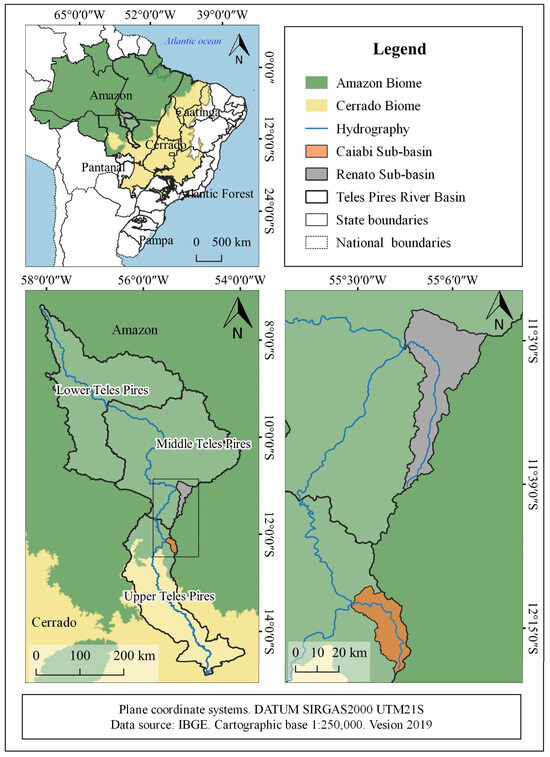
Figure 1
Open AccessArticle
Spatial and Seasonal Patterns of Mercury Accumulation in Paddy Soil around Nam Son Landfill, Hanoi, Vietnam
by
Nguyen Thi Quynh, Huiho Jeong, Ahmed Elwaleed, Willy Cahya Nugraha, Koji Arizono, Tetsuro Agusa and Yasuhiro Ishibashi
Soil Syst. 2024, 8(1), 30; https://doi.org/10.3390/soilsystems8010030 - 04 Mar 2024
Abstract
Landfills have the potential to contribute to mercury (Hg) pollution, due to the burial of waste containing mercury. Mercury from domestic waste can enter the soil surrounding landfills through surface runoff and leachate. In this study, we assessed the levels of Hg in
[...] Read more.
Landfills have the potential to contribute to mercury (Hg) pollution, due to the burial of waste containing mercury. Mercury from domestic waste can enter the soil surrounding landfills through surface runoff and leachate. In this study, we assessed the levels of Hg in the paddy soil around the Nam Son landfill, the largest landfill in the North of Vietnam, during both rainy (September 2021) and dry (January 2022) seasons. The concentration of Hg was in the range of 20.5 to 79.7 μg/kg dry w.t. in Bac Son and Nam Son, and 16.6 μg/kg dry w.t. at a higher reference site. In most of the samples, the rainy season showed higher Hg concentrations than the dry season. Soil samples taken closer to the landfill exhibited higher levels of Hg contamination compared to those in more distant paddy areas, suggesting a decreasing trend of Hg concentration as one moves away from the pollution source. Additionally, Hg concentration was found to decrease vertically from the surface, with the higher value observed in the surface layer (0–5 cm), and the lower in the bottom layer (20–25 cm). The geo-accumulation index showed that all the sampling points were moderately to heavily polluted, indicating that Hg was lost from the waste source in the landfill. This study provides valuable insights into the spatial and vertical distribution of Hg pollution in the topsoil and highlights the importance of managing and assessing the risks of Hg-containing waste.
Full article
(This article belongs to the Special Issue Mercury Biogeochemical Cycling in Soils and Sediments)
►▼
Show Figures
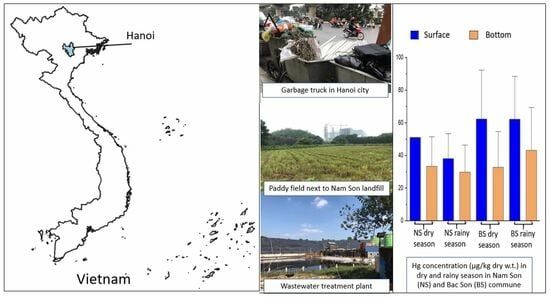
Graphical abstract
Open AccessArticle
Integrating United Nations Sustainable Development Goals in Soil Science Education
by
Elena A. Mikhailova, Christopher J. Post and Davis G. Nelson
Soil Syst. 2024, 8(1), 29; https://doi.org/10.3390/soilsystems8010029 - 29 Feb 2024
Abstract
►▼
Show Figures
The United Nations (UN) Sustainable Development Goals (SDGs) offer an opportunity to improve soil science education on sustainability because they provide specific context to educate faculty and students from various disciplines, including Science, Technology, Engineering, and Mathematics (STEM) about SDGs. Soil science is
[...] Read more.
The United Nations (UN) Sustainable Development Goals (SDGs) offer an opportunity to improve soil science education on sustainability because they provide specific context to educate faculty and students from various disciplines, including Science, Technology, Engineering, and Mathematics (STEM) about SDGs. Soil science is a STEM discipline with a wide range of applications in the SDGs. The objectives of this study were to use a matrix approach (framework for presenting options for discussion and implementation) to integrate SDGs into an existing introductory soil science course taught to undergraduate students from different STEM fields (environmental and natural resources; wildlife biology; and forestry). The course was enriched with a lecture on SDGs and students were asked to link soil properties and class activities to specific SDGs. A post-assessment survey revealed an increase in students’ familiarity with SDGs, and their relevance to soil properties and course activities. Students acknowledged the importance of soils and individual actions for achieving the SDGs. There was an overall increase in student familiarity (+59.4%) with SDGs. Most students agreed (46.7%) and strongly agreed (23.3%) that the course activities were an effective way to learn about SDGs with examples from soil science. Identified learning gaps in subject matter found through the surveys on SDGs were clarified during later classroom discussions. The advantage of this teaching approach is that it seamlessly integrates SDGs with existing course materials while relying on students’ critical thinking skills to effectively analyze soil science information and form a judgement on how it relates to SDGs.
Full article

Figure 1
Open AccessArticle
Different Quality Classes of Decomposing Plant Residues Influence Dissolved Organic Matter Stoichiometry Which Results in Different Soil Microbial Processing
by
Ratanaporn Poosathit, Benjapon Kunlanit, Frank Rasche and Patma Vityakon
Soil Syst. 2024, 8(1), 28; https://doi.org/10.3390/soilsystems8010028 - 28 Feb 2024
Abstract
►▼
Show Figures
The influence of the quantities and ratios of dissolved organic carbon (DOC) and dissolved nitrogen (DN) generated by different chemical quality classes of organic residues on soil microbial processes in the decomposition process is not well understood. If the DOC-to-DN ratio (hereafter, ratio)
[...] Read more.
The influence of the quantities and ratios of dissolved organic carbon (DOC) and dissolved nitrogen (DN) generated by different chemical quality classes of organic residues on soil microbial processes in the decomposition process is not well understood. If the DOC-to-DN ratio (hereafter, ratio) of the substrate is close to that of the microbial C-to-N ratio, then the DOC-and-DN stoichiometry of the substrate is balanced, resulting in enhanced microbial processing, i.e., carbon use efficiency (CUE). Uncertainty exists about the influence of DN and the DOC-to-DN ratio on CUE, particularly in high-quality class (high nitrogen) residue-treated soils. A long-term field experiment was used to explore the effect of the annual application of residues of different quality classes on decomposition processes, focusing on the effects of DOC, DN, and the ratio on the microbial metabolic quotient (qCO2), which is the inverse of CUE. DOC and DN were extracted from soils during the 13th year of the experiment. Soils treated with high-quality class groundnut residue (high-nitrogen) had higher DN (5.4 ± 2.6 mg N kg−1) and a lower ratio (6.8 ± 2.6) than those treated with medium-quality (medium-nitrogen) tamarind (3.0 ± 0.6 and 10.7 ± 2.2, respectively). The positive influence of DN on qCO2 (R2 = 0.49 *) in groundnut-treated soil suggested that the high bioavailability of DN reduced CUE due to imbalanced DOC-and-DN stoichiometry. This contradicted earlier published findings on high-nitrogen residues which had balanced DOC-and-DN stoichiometry. The positive influence of the ratio on qCO2 under the tamarind-treated soil (R2 = 0.60 *) indicated that its balanced DOC-and-DN stoichiometry enhanced CUE. High-quality class organic residues can result in either higher or lower CUE than their lower-quality class counterparts depending on whether the resulting DOC-and-DN stoichiometry is balanced or imbalanced.
Full article

Figure 1
Highly Accessed Articles
Latest Books
E-Mail Alert
News
Topics
Topic in
Environments, Forests, Land, Remote Sensing, Soil Systems
New Advances in Vegetation Dynamics and Soil Systems Related to Biogeochemical Cycles
Topic Editors: Hirohiko Nagano, Hiroki Ikawa, Morimaru Kida, Masataka NakayamaDeadline: 30 June 2024
Topic in
Remote Sensing, IJERPH, Water, Environments, Soil Systems
Organic Pollution in Soil and Groundwater
Topic Editors: Jinguo Wang, Zhi Dou, Hu Zheng, Chao ZhuangDeadline: 15 September 2024
Topic in
Agriculture, Agronomy, Microorganisms, Plants, Soil Systems, Nitrogen
Carbon and Nitrogen Cycling in Agro-Ecosystems and Other Anthropogenically Maintained Ecosystems
Topic Editors: Jie Li, Adnan Mustafa, Jan FrouzDeadline: 30 September 2024
Topic in
Agrochemicals, Environments, Water, Toxics, Soil Systems, Microplastics, Microorganisms, Sustainability
The Challenges and Future Trends in Anthropogenic and Natural Pollution Control Engineering
Topic Editors: Chenyang Zhang, Fujing Pan, Xiaoyu Gao, Weiqi Fu, Anxu Sheng, Zhiqiang Kong, Lei He, Sining Zhong, Jie ChenDeadline: 31 December 2024

Conferences
Special Issues
Special Issue in
Soil Systems
Crop Response to Soil and Water Salinity
Guest Editors: Anna Tedeschi, Xian XueDeadline: 30 April 2024
Special Issue in
Soil Systems
Integrated Soil Management: Food Supply, Environmental Impacts, and Socioeconomic Functions
Guest Editors: José L. S. Pereira, Vítor João Pereira Domingues MartinhoDeadline: 15 May 2024
Special Issue in
Soil Systems
Advances in the Prediction and Remediation of Soil Salinization: 2nd Edition
Guest Editors: Mandana Shaygan, Mansour EdrakiDeadline: 31 May 2024
Special Issue in
Soil Systems
Advances in Fertilizer Technologies and Use to Improve Nutrient Efficiency and Minimize Environmental Impacts
Guest Editors: Flávio Henrique Silveira Rabêlo, Douglas Guelfi, Heitor CantarellaDeadline: 30 June 2024




